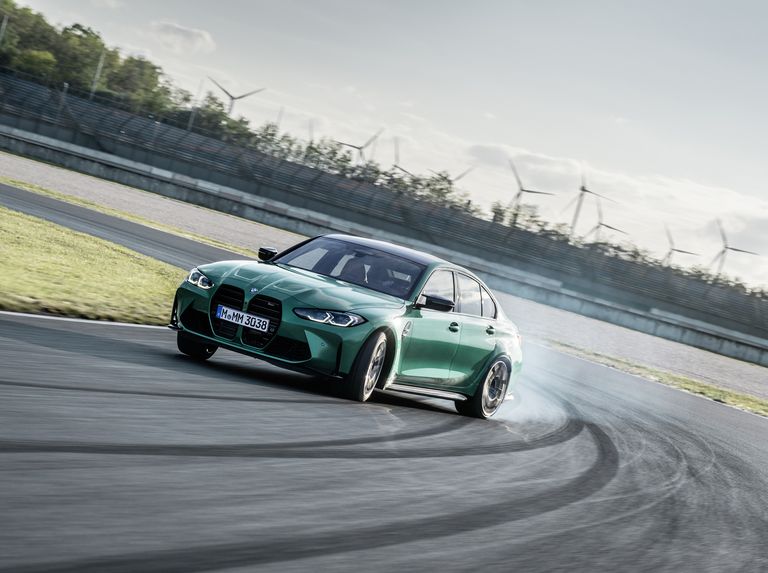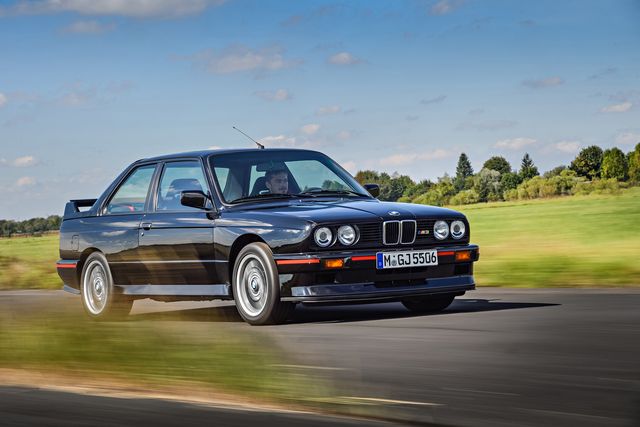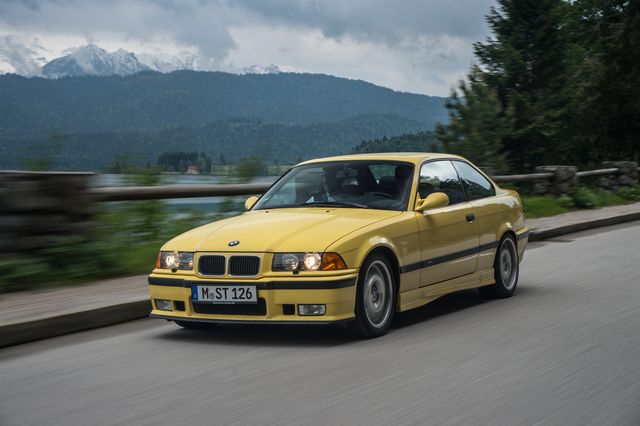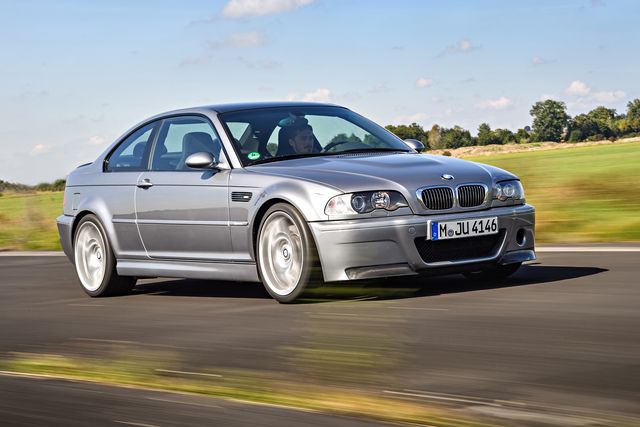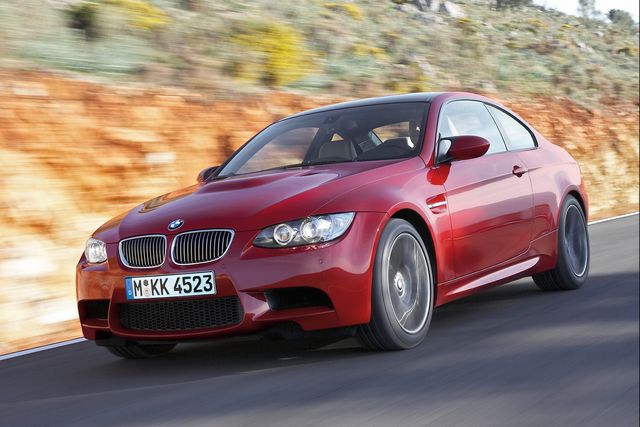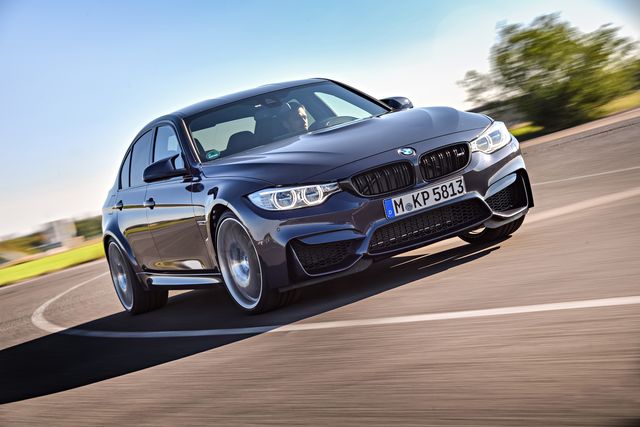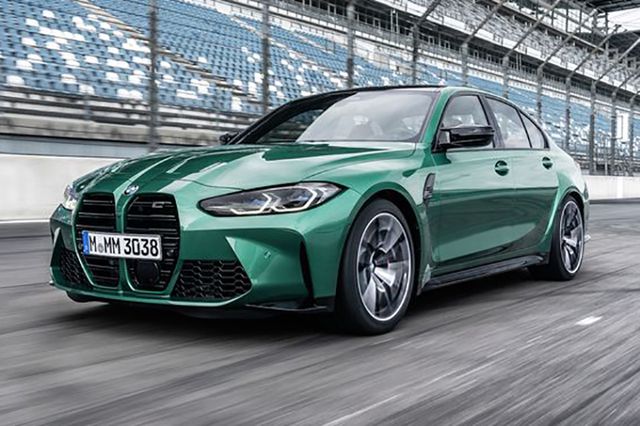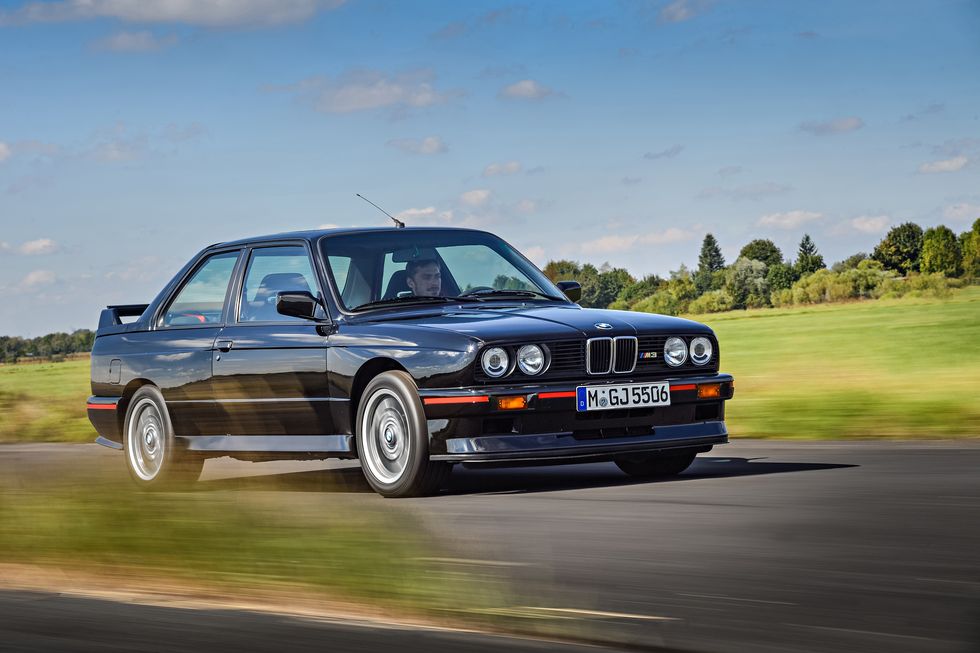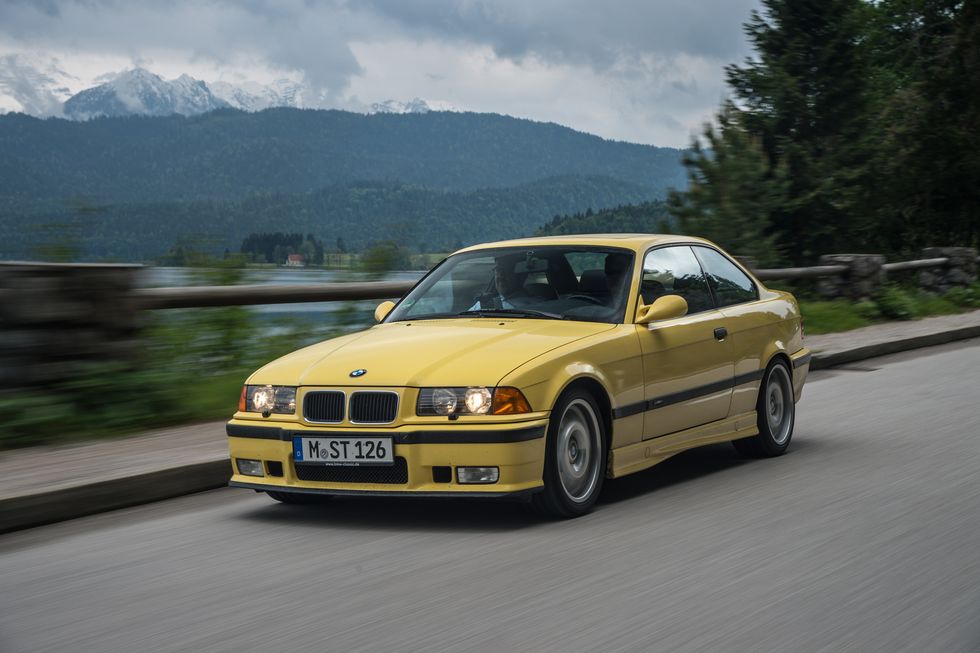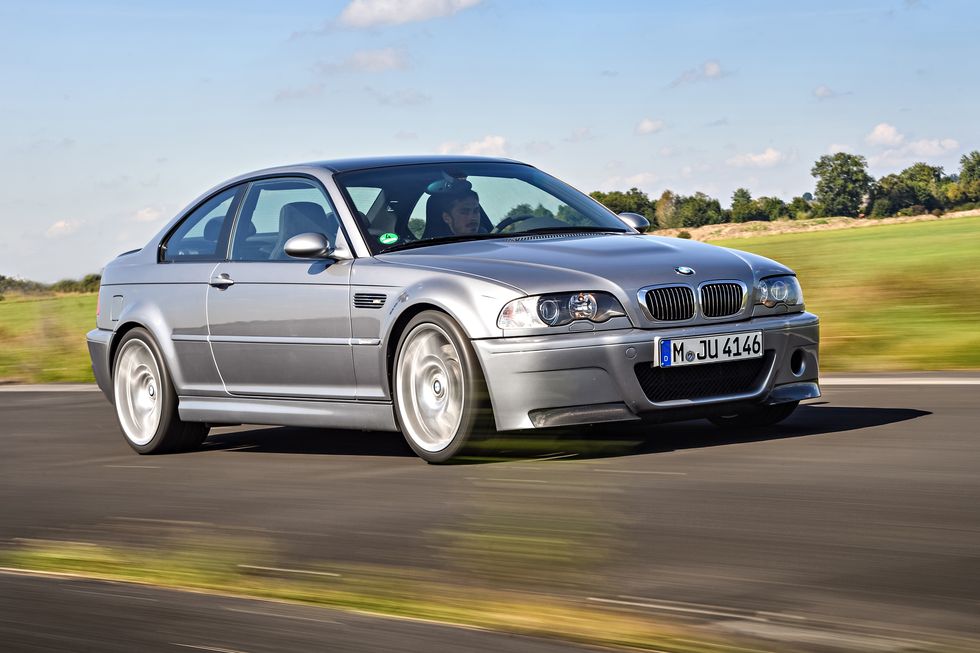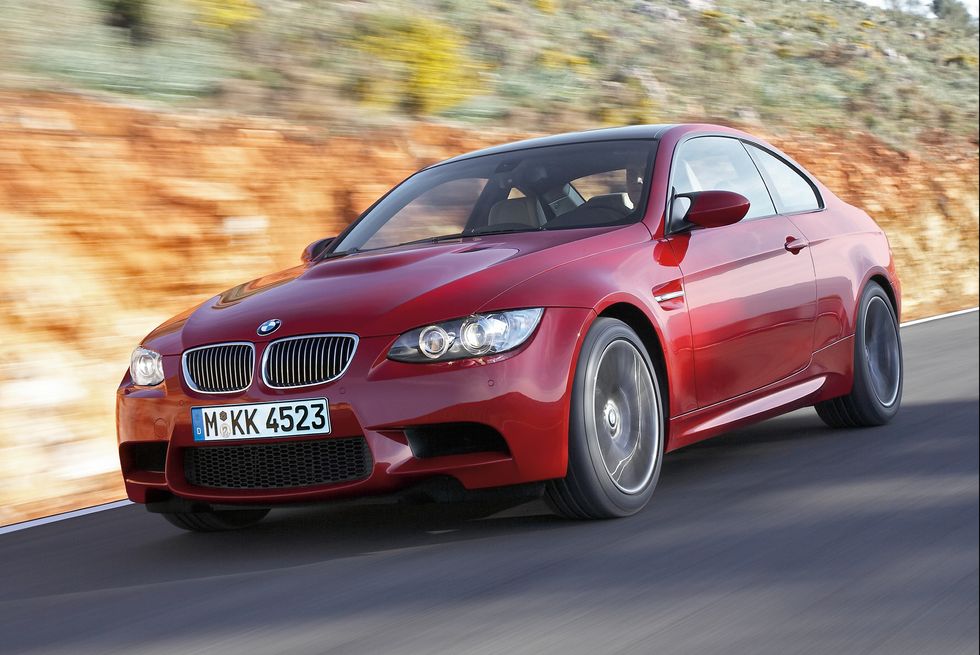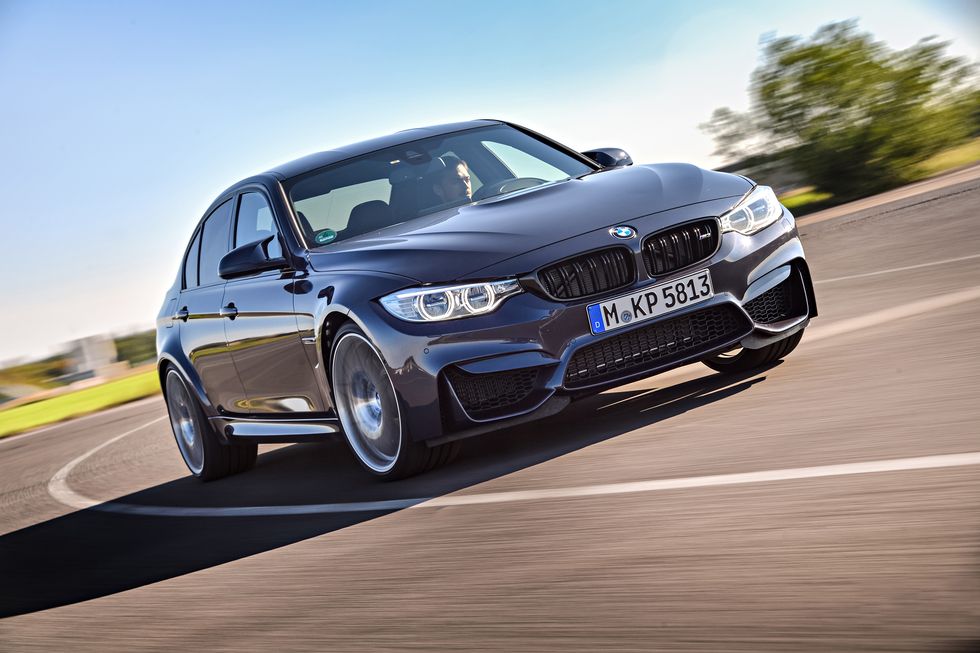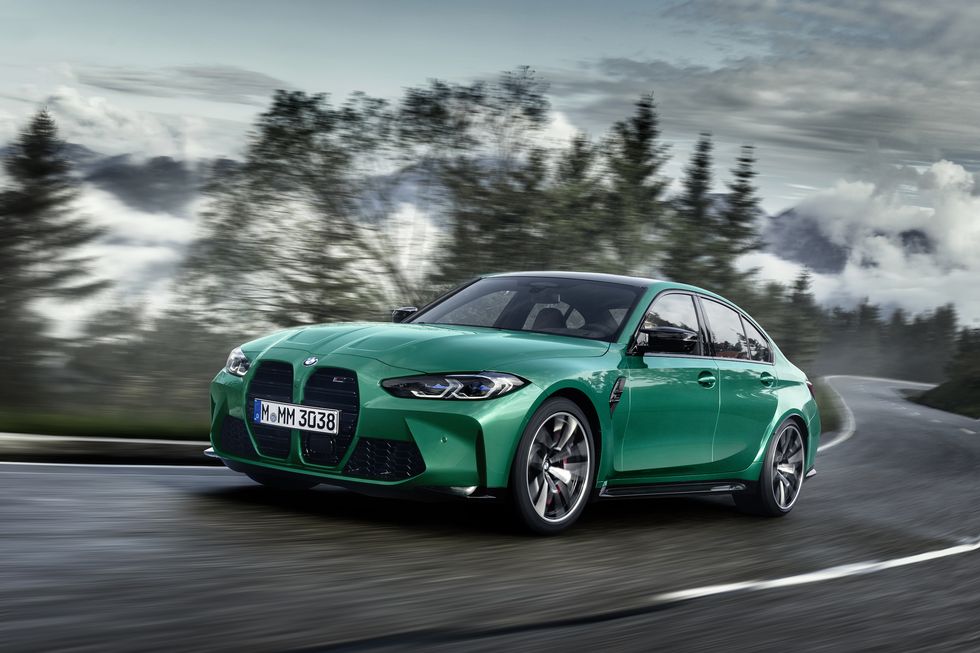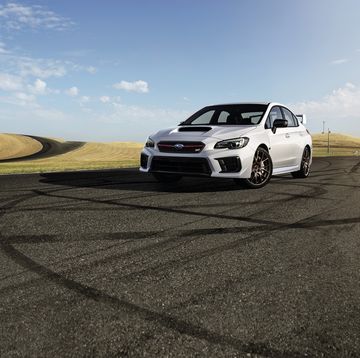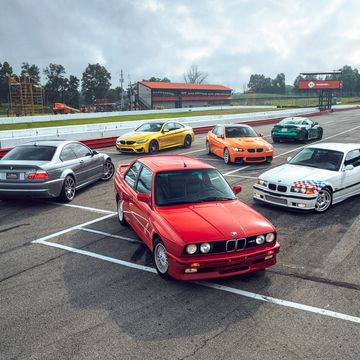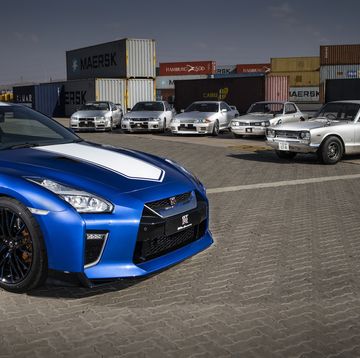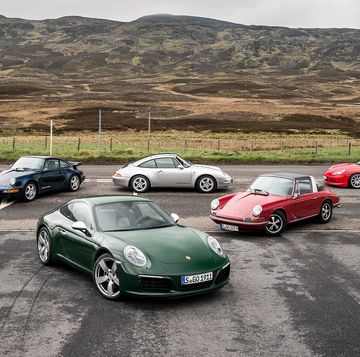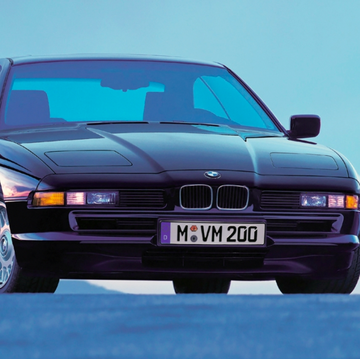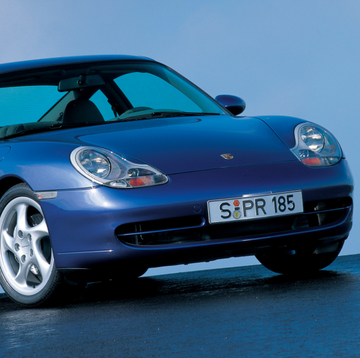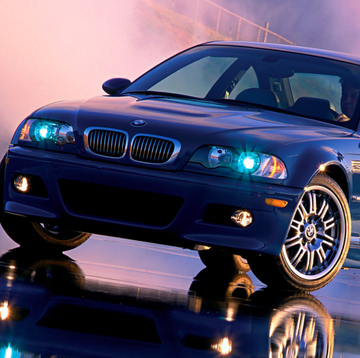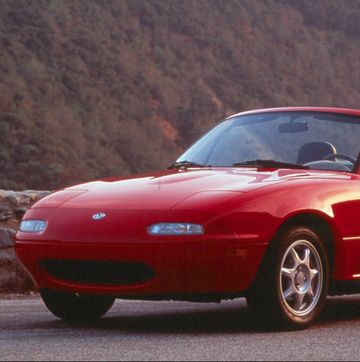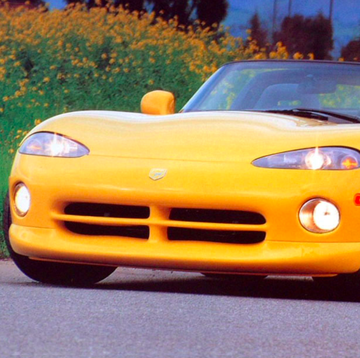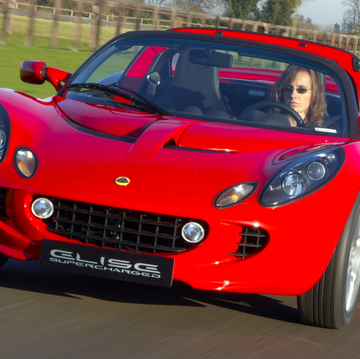Overview
The M3 is BMW’s most extreme compact sports coupe and sedan. Based on the 3-series, M3s receive unique and more-powerful engines, different suspension parts, larger brakes, and subtly re-skinned bodies. In production since the mid-Eighties, the first M3 arrived in North America for the 1988 model year.
Several generations of M3 followed, each bringing more performance and power, but throughout, the M3 has remained a car aimed at the enthusiast heart; great on a track, comfortable while blasting along at autobahn speeds, and easygoing enough to run errands and commute in. Practical and fun, if you need one car that does it all, it’s hard to beat an M3.
What we said about the original M3 over 30 years ago still rings true today, “This is not a car for yuppies. This is a car for us.” – Car and Driver, November 1987, "1988 BMW M3"
Generation One (E30): 1986-1991
While the first M3 debuted at the Frankfurt auto show in 1985, it didn't arrive in the U.S. until 1987 for the 1988 model year. Born to race in the European Touring Car Championship, the street-going M3s were built to comply with the mid-80s FIA Group A rules that required that at least 5000 street-legal copies of the race car. Today, BMW claims the E30-based M3 is the winningest touring car in history.
Built for competition, the E30 M3 sports a number of changes when compared to standard E30 coupe. The M3 wears flared fenders to cover wider tires, its nose has a lower air dam and its tail is higher to improve aerodynamics. Even the M3's rear-window angle was altered (compared to your standard E30) to help manage airflow. So much had to be changed for the M3 that the only exterior body panels it shares with the regular 3-Series were the hood and the roof. Inside, it's mostly standard E30 trim, with some special, race-oriented touches like a gauge cluster that displays oil pressure (instead of mpg), a steering wheel with BMW M-stripe accents, and unique patterns adorning M3s with cloth seats, among other small changes.
The M3's high-revving 2.3-liter four-cylinder S14 engine used a block similar to a four-cylinder 3-Series, but the M3 received its own dual-overhead-cam, 16-valve cylinder head. Output for U.S. models was 192 horsepower, so this M3’s 6.9-second time to 60 is unlikely to win many modern drag races, and it isn’t much quicker than a contemporary 325i. Outside the United States, the S14 engine grew to 2.5-liters for the special-edition "Sport Evolution" models (built from the 1989 model year on), with output rising to 235 horsepower for the final incarnation of the M3, known as the "Sport Evolution 2."
• European models are now old enough to be imported into the United States under rules that allow cars more the 25 years old to come in, but some states (like California) require emission compliance to register the car.
• European models with the close-ratio five-speed gearbox have a “dog leg” shifter with first gear located down and to the left. U.S. market cars use a wide-ratio box with a conventional shifter pattern.
• While E30 models are known to be robust, the M3’s solid lifters demand periodic valve adjustments. Look also for wear on suspension pieces and the points where they connect to the body.
• Rust isn’t a problem for cars from the sunshine states, but snowbelt cars can be affected. Look for spots where water is likely to puddle; along the windshield’s base, in the channel along the trunk rim, along the sunroof's seals, and along body seams.
• Look for modifications made for track use. Aftermarket chips and other components may make the E30 M3 better on a track, but stock vehicles are often more desirable to collectors.
Of Note:
- 1987 – The M3 “Evolution” went on sale outside the United States with a revised cylinder head. Power ratings did not rise on the road cars, but the engine changes were needed to keep pace in racing. This is not widely considered to be unique model by enthusiasts, though BMW officially labels it as such after building roughly 500 examples.
- 1988 – The M3 "Evolution II" appeared in Europe with revised spoilers and bigger wheels and tires. The engine was massage with increased compression, a revised air intake, and tweaked engine management software. These cars are easily identified by their valve covers, which feature three painted stripes of the BMW M livery.
- 1988 — BMW produced only 786 M3 convertibles in the E30 generation. None were exported to the United States by BMW. However, they are now among the most valued M3s.
- 1990 – The "Sport Evolution II" model was produced featuring thinner window glass, adjustable spoilers, bigger wheels and tires, and lightweight body work. It inherited the larger, 2.5-liter engine from the "Sport Evolution" model, but the Evo 2 further pushed its output to 238 horsepower. No, the Evo 2 wasn’t exported to America either.
Generation Two (E36): 1992-1999
Built primarily for the street, rather than a homologation special, the second-gen (E36) M3 sold in much higher numbers than its predecessor. Despite its more-pedestrian roots, the M3’s handling and performance lived up to the name. Car and Driver named it the best-handling car at any price in 1995.
Americans had to wait until the 1995 model year for the E36 M3, and when it arrived, it had a less exotic engine than the rest of the world enjoyed. While Europeans received a high-revving S50 3.0-liter inline-six with 286 horsepower, Americans got a 240-hp 3.0-liter version of the engine in the 325i. Enthusiasts were skeptical of the lower-performance engine, but the American M3 was still capable of hitting 60 mph in 5.6 seconds. A four-door M3 arrived in 1996, and a convertible debuted for 1997. In 1996, BMW bumped displacement to 3.2 liters to increase torque, but the 240-hp number remained unchanged. A five-speed automatic also debuted in 1996, but the automatic adds over a second to the zero-to-60 time. Plentiful and reasonably reliable, the E36 M3 is usually the most affordable of all M3s.
• This is the first M3 to use the VANOS variable valve timing technology. Seals on the solenoid that operate the system will wear and fail.
• Expect to replace most of the cooling system at about 60,000 miles. That includes the water pump, hoses, radiator, and seals.
• Differentials are another possible failure point. U.S. models used a smaller differential than the more powerful European versions.
• While the E36 M3 still looks contemporary, the youngest ones are now a quarter century old. If the handling doesn’t seem up to snuff, it’s very likely that the rubber in the suspension hasn’t been replaced. Changing bushing and worn out suspension components will restore the car, but will be expensive.
• Rust isn’t a major problem in cars from warm-weather areas. But every used car should be thoroughly inspected for rot.
Of Note:
- 1994 – A year before the E36 M3 went on sale in the United States, 45 examples of the European-spec M3 with the full 286 horsepower were sent to Canada. That’s a large country just north of the United States. Finding one of those 45 would at least be a great conversation starter.
- 1995 – The M3 GT is offered in Europe with up to 295 horsepower. It was only available painted in British Racing Green or silver, and is now eligible to be imported into the United States under the 25-year rule. The GT came with lightweight door skins and a swath of green leather in the center of its microsuede seats.
- 1995 – At the tail end of the E36 M3’s first model year in the U.S., BMW offered 126 Lightweight models (85 for the U.S. and 31 for the rest of the world). Lightened and refocused for the track, the Lightweight is the rarest and most desirable of the U.S. E36-generation M3.
- Manual M3s command a premium over the five-speed automatic. While the automatic doesn’t have the issues of the later single-clutch automated manual, the E36’s conventional automatic saps performance and acceleration.
- Generally, the two-door M3s have the highest values. Sedans and convertibles are worth slightly less than the coupes.
- The E36 interior isn’t nearly as nice as what the brand put in the contemporary 5-series and 7-series. The cheap plastics crack and fade, glovebox doors sag, the center vents pull away from the instrument panel, and the LEDs in the radio and HVAC displays often fail.
Generation Three (E46): 2000-2006
Unlike the E36 M3, the E46 M3 brought all the good stuff from Europe to the U.S. market. Attractive in coupe and convertible form with flared fenders and unique bodywork, the sedan version sat out the E46 generation. A naturally aspirated 3.2-liter inline-six with 333 horsepower allowed the E46 M3 to hit 60 mph in less than five seconds.
The engine boasts an 8000-rpm redline and pulls hard throughout the rev range. Unfortunately, this six lacks the smoothness of the E36’s engine. The exhaust has a particularly metallic rasp that some may find distasteful. While powerful, the engine suffers from rod bearing issues.
Avoid the clunky single-clutch automatic (SMG) at all costs and go for the manual. While it’s possible to convert the SMG to be a manual, you’re better off starting with the manual version.
The E46 M3 also has a harsher ride than any M3 before or after it. It’s borderline unbearable on the optional 19-inch wheels. Despite that, many consider the E46 the best-driving M3 ever made, with impeccable balance and a splendid interior layout.
A strong seller, about 85,000 of them were built.
• The E46 M3’s S54 engine can experience connecting rod bearing failures, so change the oil more often than the onboard computer demands. A 5000-mile interval is cheap insurance. The engine uses a specific 10W-60 oil.
• All E46 rear subframe mounts are prone to cracks and very expensive to fix. A thorough inspection of the subframe requires it to be removed. Reinforcement kits are available.
• Avoid the Sequential Manual Gearbox (SMG) automated transmission. This is literally the manual six-speed transmission converted to computerized operation. Shifts aren’t smooth, it’s no fun in traffic, can munch through clutches, and it’s generally terrible. The only bright spot with the SMG system is that it can be converted into a six-speed manual.
Of Note:
- 2003 – Europe got the exotic, lightweight M3 CSL model inspired by BMW’s CSL racing machines of the 1970s. But they’re Europe-only and won’t be legal in the United States until 2028. Be patient.
- 2004 - 2006 – Many of the CSL’s lightweight components were incorporated into the M3 Competition Package offered in America between 2004 and 2006. That included a quicker steering rack and an Alcantara wheel to operate it, larger cross-drilled brake rotors and unique 19-inch wheels.
Generation Four (E90): 2008-2013
The fourth-gen M3 brought the V-8 engine to the M3. And what a V-8. Purpose-built for the M3, the 4.0-liter V-8 offers up 414 horsepower and an 8400-rpm redline. This is arguably the best-sounding M3 ever made.
That special V-8 thundered and pulled in a way that its predecessors could not match. The V-8 weighed 33 pounds less than the previous inline-six, but the E90 generation is heavier than its predecessor. Despite a carbon-fiber roof panel on models without a sunroof, the coupe coupe weighed about 200 pounds more than before. The new chassis improved the ride, but kept the track-ready potency intact, even with the added weight.
As before it was offered as a two-door coupe, two-door convertible, or four-door sedan. Subtlety? Even the hood bulges. BMW sold it with a six-speed manual and an excellent seven-speed dual-clutch automatic.
Like the E36, the E90 has depreciated to tantalizingly low price levels. Snagging one with higher mileage for under the price of a new Miata is easy. But there are still some things you should be aware of.
• The V-8 engine is robust and reliable. Mostly. Be on the lookout for any indications of connecting-rod or main-bearing wear. Also be aware of any faults from the two throttle actuators that can trigger the main ECU’s limp-home mode. Parts are very pricey for this one-off engine.
• Don't expect it to be easy to fix if something does goes wrong. This M3 is thoroughly more modern than any of its predecessors, meaning lots of computers and electrical systems all intertwined.
• It will burn oil. Lots of it, if you explore the car's upper rev range often. It takes expensive 10W-60 weight, too. Make sure to have some stashed in the trunk in case you ever get low.
• Models equipped with iDrive-controlled infotainment and settings can be avoided and should be avoided. The system is largely reliable, but if you can avoid the dated displays, menus, and terrible user experience you should definitely do that. Plus, the instrument panel won’t have a big ugly hump for the display in it.
Of Note:
- 2010 – What is perhaps the meanest of all M3s appeared this year in the form of the M3 GTS. Practically built by hand, the GTS came with a titanium exhaust system and a stripped-down interior that included a standard roll bar and omitted the rear seat, it weighed about 100-pounds less than other M3 coupes. But the M3 GTS’ most exotic feature was a version of the V8. Enlarged to 4.4-liters and making 450-horsepower, the GTS cost nearly twice as much as a regular E90 M3. None were officially exported to the United States. It was available in any color you wanted, as long as that was orange. Only 135 were built.
- 2011 – BMW produced 67 four-door versions of the GTS wearing the name M3 CRT. These E92-generation specials were not brought to the States.
- 2011 – BMW adds a Competition Package to U.S. M3s. With it, the M3 is lowered by millimeters, and changes to the stability control system facilitate more aggressive cornering before the system intervenes. New 19-inch wheels come along with that package as well.
Generation Five (F80): 2014-2018
The The inline-six returned to the M3 with the F80 generation, but this time with two turbochargers and 425 horsepower in regular trim while later “Competition” versions made 444 horsepower. What didn’t return were the coupe and convertible as BMW rebranded those as M4s to match their 4-series compatriots. Again six-speed manual or seven-speed automated transmissions were offered. C/D tested a 2016 Competition model with the dual-clutch transmission and ripped to 60 mph in a stunning 4.0 seconds.
Power came from the “S55” version of BMW’s twin-turbo inline-six engine. This is the first production M3 with a turbocharged engine. Unlike its high-revving predecessors, the turbocharged enabled an easily accessed and fat torque curve. Torque peaked at 406 pound-feet at a low 1850 rpm and stayed there until way up at 5500 rpm.
Both six-speed manual and seven-speed dual-clutch (DCT) automatic transmissions were available. The six-speed may be more fun, but the DCT shifts quicker than humanely possible and offers launch control for easy and repeatable acceleration runs.
As this is written, these are recent machines. Used cars instead of established classics. Many of the problems that come with age and mileage aren’t fully known yet. And since they’re all sedans, the more-exotic variations on the M3 themes are now M4s.
• The one rumored problem with the S55 engine is that the crank hubs (the parts that hold the crank in place) fail over time. Careful inspection of this component is necessary. The internet is ablaze with accusations that this problem is a fantasy created to sell unnecessary aftermarket solutions for it. Hey, time will tell.
• Turbocharged engines are amenable to tuning through computer tweaks. Look out for re-flashed programming that can produce big dyno numbers but destroy everyday driving friendliness and longevity. Many of these cars are still under the factory warranty, and screwing with the engine will void that guarantee.
Of Note:
- Carbon ceramic brakes were a pricey option on the M3, but might be worth seeking but if you plan to take your M3 to the track. They shed heat better, fade less, last longer, and are built to take abuse.
- 2016 – This is the first year for the Competition Package that brought with it a modest power bump, larger wheels and tires, and revised programming for electronic limited-slip differential.
- 2016 – BMW issued a special 30th anniversary edition of the M3 covered in Macao Blue paint and including the Competition Package, special M-Sports seats, and every other desirable option. Both manual and dual-clutch automatic transmissions were available and production was limited to 500 worldwide.
Generation Six (G80): 2021-?
The G80 is the newest entry into the M3 lineage. Like the previous car, an M4 coupe and convertible means the M3 is sedan only for the G80. Under the hood sits a twin-turbo straight-six dubbed the S58, available in a base 473 horsepower tune or a hopped-up 503-horsepower Competition guise. Go for the standard car, and your transmission is a six-speed manual as standard. Opt for the Competition, and you'll get an eight-speed automatic.
The M3 and M4 are the first M cars to use the company's new massive vertical grille design, which debuted on the 2021 4-Series. Our staffers aren't exactly fans, with associate editor Mack Hogan calling them "heinously ugly" in our track review. That being said, we like the proportions of the four-door M3 better than the sometimes-awkward-looking two-door M4.
The engine is gushing with power in both base and Competition trims, delivering a fat, meaty torque curve throughout the rev range. The steering, in typical BMW fashion, is devoid of any real feel. It is, however, one of the most direct and accurate racks put into an M car in recent memory. We also love the car's front-end grip and balance.
What we don't like is the car's overall heft. It makes everything too distant to be fun. And while we're glad BMW offers a manual gearbox, the one in our M4 tester had an unsettlingly light clutch pedal and a rubbery shifter that was tough to shift quickly.
It's also worth noting this is the first M3 to be available with all-wheel drive. An M-tuned xDrive option will become available in summer 2021 for Competition models, set to perform similarly to the trick system found in the current M5 and M8.
As for reliability, well, there's no telling at this point. The car is brand-new. We'll update this article when we hear from owners about their experiences.
Of Note:
- The G80-generation M3 is the first M3 to be offered in a wagon body style. Unfortunately, because Americans don't buy wagons, that variant is not going to be sold in the United States.
- Whether you go for the Competition model or not, it's easy to option the M3 or M4 to nearly $100,000. We suggest avoiding expensive add-ons like the $8150 carbon-ceramic brakes and $4700 carbon exterior package.
- One must-have option are the M carbon bucket seats. They cost $3800, but the lateral support and low-slung mounting points mean a much-improved driving experience. Just be weary of the high thigh bolsters.
Collectability
Built from 1987 until 1991, the original M3 is the version that has attracted the most attention from collectors. It’s the rarest generation and the homologation aspect of its creation adds to its mystique. A total of 17,970 first-gen M3s were built—17,184 two door coupes and 786 cabriolet convertibles. The convertible never made it stateside. In the U.S., a naturally-aspirated 2.3-liter, DOHC, 16-valve four-cylinder engine with 192 horsepower powered all of them and they’re all manuals. The E30 is not only the rarest of the M3s, it’s also the only one powered by a four-cylinder engine.
The most collectible M3s of all five generations are the “Evolution” and other lightweight models optimized for racing use. While these cars were never imported, many are now old enough to be legally brought to the U.S. for road use. These semi-exotic M3s were built in small numbers, have more power, sport exotic features, and were more expensive when new.
The Ones to Get
- A mere 786 E30 M3 Cabriolets were built and none for North America. Three separate E30 M3 Evolution series were issued and are as rare as they are coveted. The Sport Evolution M3 was the last of the series, only 600 were made.
- In 1995 a mere 85 E36 M3 Lightweight coupes were built for the United States market and another 31 for the rest of the world. They weighed a little less than the regular M3 coupe, but the powertrain remained unchanged.
- M also produced 350 M3 GT models with tweaked engine programming to boost engine output to 295-horsepower. All these were painted British Racing Green and none were sold in the United States.
- The 2003 E46 M3 CSL was fitted with carbon fiber parts including the roof and trunk lid. Thinner rear window glass saved curb weight and the car's 3.2-liter straight six was massaged to make more power. The U.S. didn’t get the CSL, but instead received the M3 Competition, which borrowed the look and a few of the chassis changes of the CSL, but didn’t get a power boost.
- King of the E92 generation is the 2010 M3 GTS coupe. It was 275-pounds lighter than standard and the V8-engine was stroked from 4.0- to 4.4-liters adding 40 horsepower in the process. BMW also produced 67 four-door versions during 2011 wearing the name M3 CRT. These E92-generation specials were not brought to the States.
- With the two-door coupe now an M4, the F80 generation M3 sedan wasn’t the focus of competition modifications. Still, there was an M3 CS that came with extra power and a stiffened suspension.
Notable Issues / Problems
- The original “S14” four-cylinder engine’s maintenance schedule calls for regular valve adjustments since it lacks hydraulic lifters.
- The E46 M3 notoriously finicky and unsmooth single-clutch (SMG) automatic is complex and expensive to fix. An automatic to manual conversion is a common, if pricey, solution. Always check the rear subframe for cracks, before purchasing.
- A few E46s had soft bottom-end bearings, although most have likely been replaced with a harder material by now.
- E90 M3 cars have proven robust. But the V-8 is unique, many of the systems are complex, and parts are exotic-car expensive. There’s no such thing as too much preventative maintenance.
Specs
Critical Reception
“This is not a car for yuppies. This is a car for us.”
– Car and Driver, November 1987, “1988 BMW M3”
“Whether I was running it around Hockenheimring, tooling through the city, or opening it up on the Autobahn, the BMW felt right at home. With just enough gear selected, the power rolls on beautifully, and the engine pulls like a demon."
– Road & Track, October 1991, “Clash of the Teutons: BMW M3 Sport Evolution vs. Audi Coupe S2 vs. Mercedes 190E 2.5-16 Evo II”
“The engine is an absolute gem. This ferocious, screaming motor hurtles the M3 down the road with an urgency that now rivals the world's best sports cars from Porsche and Chevrolet. BMW estimates the M3 will hit 60 mph in just 4.8 seconds and will eat up a quarter-mile in 13.5 seconds.”
– Car and Driver, December 2000, “2001 BMW M3”
“When will the madness stop? When will we have enough power? It should be a clue that we have plenty when powering along the Autobahn, the new BMW E92 M3 hits an imaginary brick wall at 161 mph. It can clearly go faster, but doesn't think we should.”
– Road & Track, December 2007, “2008 BMW M3”
“The big news for this fifth generation of M3 is the return of the inline-six. The M3 might have started with a four back in 1986 and worked up to a V8 in 2007, but the straight-six, the quintessential BMW engine, is the engine that we most closely associate with the M3.”
– Road & Track, May 2014,“2015 BMW M3 and M4”
